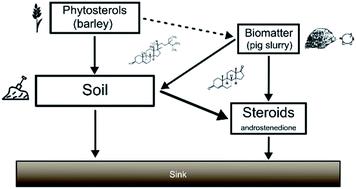当前位置:
X-MOL 学术
›
Environ. Sci.: Processes Impacts
›
论文详情
Our official English website, www.x-mol.net, welcomes your feedback! (Note: you will need to create a separate account there.)
In situ formation of environmental endocrine disruptors from phytosterol degradation: a temporal model for agricultural soils
Environmental Science: Processes & Impacts ( IF 5.5 ) Pub Date : 2021-4-28 , DOI: 10.1039/d1em00027f Thorsten Klaus Otto Gravert 1 , Patrik Fauser 1 , Preben Olsen 2 , Martin Hansen 1
Environmental Science: Processes & Impacts ( IF 5.5 ) Pub Date : 2021-4-28 , DOI: 10.1039/d1em00027f Thorsten Klaus Otto Gravert 1 , Patrik Fauser 1 , Preben Olsen 2 , Martin Hansen 1
Affiliation

|
We propose a conceptual model that describes the in situ formation of androstenedione in agricultural soil from a phytosterol, β-sitosterol, released after crop harvest and soil fertiliser amendment. Based on the recorded agricultural practice at a spring barley field, β-sitosterol and androstenedione concentrations were modelled over the year. While decomposition of crop residues created low soil levels, the application of pig slurry led to an androstenedione soil concentration of 54 μg kg−1. The elevated soil concentration of androstenedione is not due to the introduction of the endocrine disruptor in the fertiliser, but a result of the addition of large concentrations of β-sitosterol as a natural precursor. The limited available data on β-sitosterol and androstenedione concentration in soil prohibited their accurate prediction by our model. However, the potential implication of endocrine-disrupting steroid hormones being formed in situ from currently little considered phytosterols justifies a conceptual description and further research.
中文翻译:

植物甾醇降解对环境内分泌干扰素的原位形成:农业土壤的时间模型
我们提出了一个概念模型,该模型描述了从农作物收成和改良土壤肥料后释放的植物甾醇,β-谷甾醇在农业土壤中原位形成雄烯二酮的情况。根据已记录的春季大麦田的农业实践,对一年中的β-谷甾醇和雄烯二酮浓度进行了建模。尽管农作物残留物的分解导致土壤水平低下,但施用猪粪浆导致雄烯二酮的土壤浓度为54μgkg -1。雄烯二酮的土壤浓度升高不是由于在肥料中引入了内分泌干扰物,而是由于添加了高浓度的β-谷甾醇作为天然前体。关于土壤中β-谷甾醇和雄烯二酮浓度的可用数据有限,这阻碍了我们模型的准确预测。然而,由目前很少考虑的植物甾醇原位形成破坏内分泌的类固醇激素的潜在含义证明了概念上的描述和进一步的研究。
更新日期:2021-04-29
中文翻译:

植物甾醇降解对环境内分泌干扰素的原位形成:农业土壤的时间模型
我们提出了一个概念模型,该模型描述了从农作物收成和改良土壤肥料后释放的植物甾醇,β-谷甾醇在农业土壤中原位形成雄烯二酮的情况。根据已记录的春季大麦田的农业实践,对一年中的β-谷甾醇和雄烯二酮浓度进行了建模。尽管农作物残留物的分解导致土壤水平低下,但施用猪粪浆导致雄烯二酮的土壤浓度为54μgkg -1。雄烯二酮的土壤浓度升高不是由于在肥料中引入了内分泌干扰物,而是由于添加了高浓度的β-谷甾醇作为天然前体。关于土壤中β-谷甾醇和雄烯二酮浓度的可用数据有限,这阻碍了我们模型的准确预测。然而,由目前很少考虑的植物甾醇原位形成破坏内分泌的类固醇激素的潜在含义证明了概念上的描述和进一步的研究。


























 京公网安备 11010802027423号
京公网安备 11010802027423号